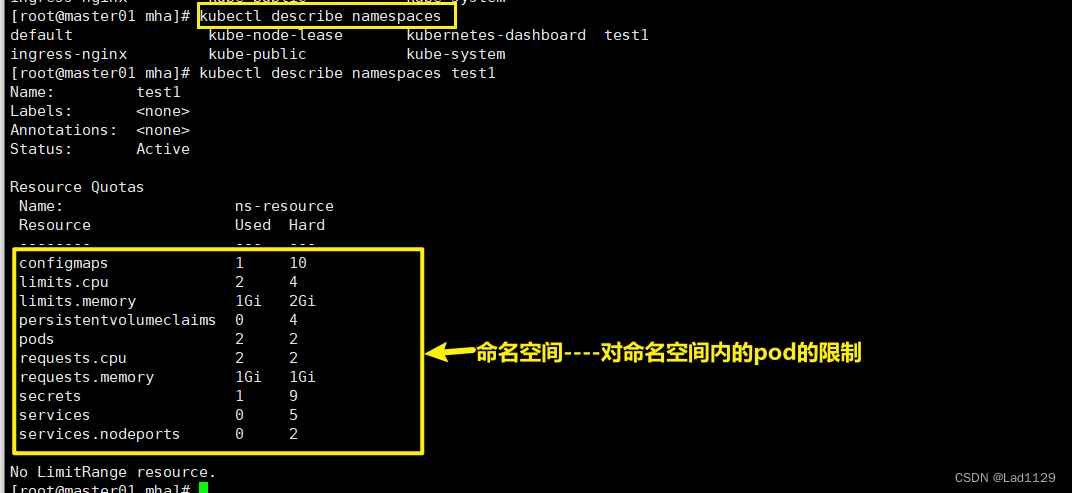HPA自动扩缩容
HPA是什么???
Horizontal Pod Autoscaling: k8s自带的模块,pod的水平自动伸缩,对象是pod。
pod占用cpu比率达到一定的阈值,将会触发伸缩机制。
replication controller 副本控制器
deployment controller 节点控制器
hpa控制副本的数量以及控制部署pod
1、hpa基于kube-controll-manager服务,周期性的检测pod的cpu使用率,默认30秒
2、hpa和replication controller,deployment controller ,都属于k8s的资源。通过跟踪分析副本控制器和deployment的pod的负载均衡变化,针对性的调整pod的副本数。
阀值: 正常情况下,pod的副本数,以及达到阀值之后,pod的扩容最大数量
3、metrics-server 部署到集群当中,对外提供度量的数据。
hpa部署
在所有节点上传metrics-server.tar包
#导入为镜像
docker load -i metrics-server.tar
#在master上传components.yaml
kubectl apply -f components.yaml
HPA的规则:
1、定义pod的时候必须要有资源限制,否则HPA无法进行监控。
2、扩容是即时的,只要超过阀值会立刻扩容,不是立刻扩容到最大副本数。他会在最小值和最大信波动。如果扩容的数量满足了需求,不会在扩容
3、缩容是缓慢的。如果业务的峰值较高,回收的策略太积极的话,可能会产生业务的崩溃。缩容的速度是比较慢的。周期性的获取数据,缩容的机制问题。
你是怎么对pod的副本数进行伸缩???
副本数扩缩容有两种方式:
1、手动方式,修改控制器的副本数
方法一
kubectl scale deployment centos-test --replicas=3
方法二
apply -f
方法三
kubectl edit deployments.apps centos-test2、自动扩缩容
hpa: hpa的监控是cpu
声明式
kubectl autoscale deployment centos-test --cpu-percent=50 --max=10 --min=1陈述式
apiVersion: autoscaling/v1
kind: HorizontalPodAutoscaler
metadata:
name: hpa-centos7
spec:
scaleTargetRef:
apiVersion: apps/v1
kind: Deployment
name: centos-test
minReplicas: 1
maxReplicas: 5
targetCPUUtilizationPercentage: 50
#超过50%就扩展资源限制:
pod的资源限制
命名空间资源限制
lucky-cloud项目-----部署在test1的命名空间,如果lucky-coloud不做限制,或者命名空间不做限制,他依然会占满所有集群资源。
k8s部署pod的最大数量:10000个
busybox: 就是最小化的centos 4M
对pod资源的限制
apiVersion: apps/v1
kind: Deployment
metadata:
name: centos-test
namespace: test2
labels:
test: centos
spec:
replicas: 1
selector:
matchLabels:
test: centos
template:
metadata:
labels:
test: centos
spec:
containers:
- name: centos1
image: centos:7
command: ["/bin/bash","-c","yum -y install epel-release.noarch; yum -y install stress;sleep 3600"]
resources:
limits:
cpu: "1"
memory: 512Mi
---
apiVersion: v1
kind: LimitRange
#表示使用limitrange来进行资源控制
metadata:
name: test2-limit
namespace: test2
spec:
limits:
- default:
memory: 512Mi
cpu: "1"
defaultRequest:
memory: 256Mi
cpu: "0.5"
type: Container
#default: 相当于limit
#defaultRequest: 相当于request
#type: Container pod pvc(很少有)
限制pod副本数
apiVersion: apps/v1
kind: Deployment
metadata:
name: centos-test2
namespace: test1
labels:
test: centos2
spec:
replicas: 10
selector:
matchLabels:
test: centos2
template:
metadata:
labels:
test: centos2
spec:
containers:
- name: centos1
image: centos:7
command: ["/bin/bash","-c","yum -y install epel-release.noarch; yum -y install stress;sleep 3600"]
resources:
limits:
cpu: "1"
memory: 512Mi
---
apiVersion: autoscaling/v1
kind: HorizontalPodAutoscaler
metadata:
name: hpa-centos7
spec:
scaleTargetRef:
apiVersion: apps/v1
kind: Deployment
name: centos-test2
minReplicas: 1
maxReplicas: 5
targetCPUUtilizationPercentage: 50
---
apiVersion: v1
kind: ResourceQuota
metadata:
name: ns-resource
namespace: test1
spec:
hard:
pods: "2"最开始副本为1,运行后deployment是1/1
限制数为2,副本数为3,运行后deployment是2/3
限制数为8,副本数为3, 运行后deployment是2/3
限制数为8,副本数为4, 运行后deployment是4/4
命名空间资源限制
apiVersion: apps/v1
kind: Deployment
metadata:
name: centos-test2
namespace: test1
labels:
test: centos2
spec:
replicas: 10
selector:
matchLabels:
test: centos2
template:
metadata:
labels:
test: centos2
spec:
containers:
- name: centos1
image: centos:7
command: ["/bin/bash","-c","yum -y install epel-release.noarch; yum -y install stress;sleep 3600"]
resources:
limits:
cpu: "1"
memory: 512Mi
---
apiVersion: autoscaling/v1
kind: HorizontalPodAutoscaler
metadata:
name: hpa-centos7
spec:
scaleTargetRef:
apiVersion: apps/v1
kind: Deployment
name: centos-test2
minReplicas: 1
maxReplicas: 5
targetCPUUtilizationPercentage: 50
---
apiVersion: v1
kind: ResourceQuota
metadata:
name: ns-resource
namespace: test1
spec:
hard:
pods: "2"
requests.cpu: "2"
requests.memory: 1Gi
limits.cpu: "4"
limits.memory: 2Gi
configmaps: "10"
#在当前命名空间能创建最大的configmap的数量 10个
persistentvolumeclaims: "4"
#当前命名空间只能使用4个pvc
secrets: "9"
#创建加密的secrets,只能9个
services: "5"
##创建service只能5个
services.nodeports: "2"
#nodeport类型的svc只能两个

总结
HPA自动扩缩容 命名空间
第一种:
ResourceQuota 可以对命名空间进行资源限制。
第二种
limitRange:直接声明在命名空间当中创建的pod,容器的资源限制,这是一种统一限制,所有的pod都受这个条件制约。
pod资源限制 一般是我们创建的时候声明好的,必加选项。
pod资源限制
resources:
limit
对命名空间资源限制,对命令空间使用cpu和内存一定会做限制(cpu、内存),防止整个集群的资源被一个服务或者一个命名空间占用。
命名空间资源限制 ResourceQuota
核心:防止整个集群的资源被一个服务或者一个命名空间占用。
命名空间统一资源限制 LimitRange
HPA:自动伸缩。 nodeName固难在一个pod,观察,扩容之后,阀值是否会下降。
本文来自互联网用户投稿,该文观点仅代表作者本人,不代表本站立场。本站仅提供信息存储空间服务,不拥有所有权,不承担相关法律责任。 如若内容造成侵权/违法违规/事实不符,请联系我的编程经验分享网邮箱:chenni525@qq.com进行投诉反馈,一经查实,立即删除!
- Python教程
- 深入理解 MySQL 中的 HAVING 关键字和聚合函数
- Qt之QChar编码(1)
- MyBatis入门基础篇
- 用Python脚本实现FFmpeg批量转换
- 大型食品企业-白象集团选择泛微搭建集团一体化的数字化办公平台
- 必要时进行保护性拷贝
- Agilent安捷伦33220A函数信号发生器
- (self-supervised learning)Event Camera Data Pre-training
- 工具--Git详解
- 2023年最新版的linux运维面试题(四)
- MVC模式
- python绘制三维图
- Linux介绍、安装、常见命令
- SqlAlchemy使用教程(五) ORM API 编程入门